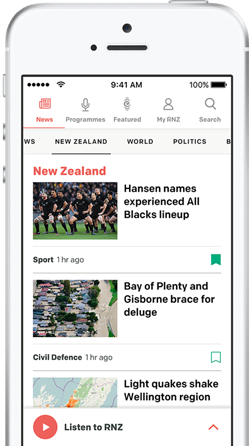
The DLI capability was announced on Friday by Minister of Police Mark Mitchell. Photo: RNZ / Victor Waters
Hato Hone St John believes a new emergency services technology to help locate people faster will mean the difference between life and death.
The new technology, the Device Location Information (DLI) service, can be used by emergency services to locate the mobile phone of a person who has not called 111 themselves but there are grave fears for their health or safety.
The DLI capability was announced on Friday by Minister of Police Mark Mitchell.
Peter Bradley, chief executive of Hato Hone St John, said they welcomed the new emergency services resource.
"This is a vital tool that will help emergency services respond faster when every second counts. The ability to quickly locate a person whose life or health is at serious risk but unable to call for help can mean the difference between life and death," Bradley said.
"Crucially, this new capability highlights the value of collaboration between emergency service agencies. By working together and leveraging shared technology, we can deliver a faster, more accurate medical response to people when they need it, wherever they may be."
The DLI service is part of a broader programme of work being led by Next Generation Critical Communications (NGCC) to modernise the critical communications infrastructure and services used by the emergency services.
NGCC is also delivering the Public Safety Network cellular services and a new Land Mobile Radio network for Police, Fire and Emergency NZ, Wellington Free Ambulance, and Hato Hone St John.
Bradley said the service will benefit time-critical situations such as where a call for help is cut short before location details can be shared.
"When a call drops, or when a person can't speak but is in clear need of help, this technology ensures we're not wasting valuable time trying to manually determine where they might be. It allows us to respond faster when a person's life or health is at serious risk," he said.
Mitchell echoed the words of Hato Hone St John.
"When every second counts, having access to real time digital technology is a game changer for our emergency services, and for public safety," Mitchell said.
He said it will be a very useful tool for search and rescue operations, for example when someone is reported missing in the bush.
"Provided they're carrying a mobile device that's switched on and connected to a cellular network, emergency services can use the DLI service to get immediate access to information about the area they are in and send help," he said.
"Our emergency services do a great job, handling over two million calls for help each year. This new capability will help them find people more quickly when speed is of the essence."
The government said they've ensured this tool is in line with the Telecommunications Information Privacy Code, with processes in place to ensure this new tool is used appropriately and transparently. They said this includes a two-step process to authorise use of the DLI service and transparently reporting on when and why it has been used.
Associate Minister of Health Casey Costello said the technology's capability is an improvement on the current process which requires manual requests to be made to mobile network operators and relies on them having people on call 24/7 to assist.
"This service can also help if a call is transferred to an emergency service from another operator. For example, if someone on the phone to Healthline falls unconscious and the call drops, then the Device Location Information service can locate the mobile device they were calling from and send this information to ambulance teams," Costello said.
Next Generation Critical Communications (NGCC) programme director Steve Ferguson said the technology was developed in New Zealand.
"It is world-leading technology and we're working closely with our counterparts in Europe, in the States, in Asia. They are looking to us, and we're working and sharing information on how we use cellular technology.
"They, too, are looking at solutions and we're looking for simple, cost-effective solutions that protect privacy and give outcomes. So, we're sharing that information."
Authorities today were quick to reassure the public the technology falls in line with privacy laws.
Police Deputy Commissioner Jill Rogers said the information gathered won't be fed back to the 111 caller or the public.
"The enhancements have been some time in the making and so to reassure people that the privacy considerations of the information that we will have access to have been well traversed.
"We've worked closely with the Office of the Privacy Commissioner. There are, as you heard this morning, strict auditing rules required for it and it will also require, in our communications centre, it to be approved to be used by our comms inspector.
"So that's a senior police officer who will make the decision on a case-by-case basis about when we will use this."
She said the search and rescue would be the predominant reason to use DLI.
Fire and Emergency National Manager of Response Capability, Ken Cooper said the service would be useful should emergency services be confronted with more deadly storms like in Cyclone Gabrielle or the Auckland Anniversary floods of 2023.
"During Gabrielle, we did lose communications for a number of times but as we've discussed, the ability to locate where the cell phone had its last connection.
"Certainly, you know, finding individuals at pace for the community would be a significant step forward."
Sign up for Ngā Pitopito Kōrero, a daily newsletter curated by our editors and delivered straight to your inbox every weekday.




